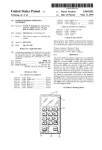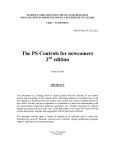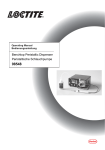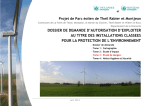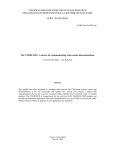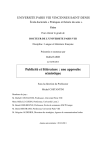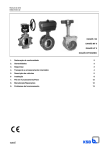Download BRHS_Chap5_Detection measures version _0_9_1
Transcript
Chapter V: HYDROGEN SAFETY BARRIERS AND SAFETY MEASURES Version 1.0 – May 2006 1 Table of content 1.2 Detection measures........................................................................................................................................ 2 1.2.1 Detection of explosive atmosphere......................................................................................................... 2 1.2.1.1 References and sources ................................................................................................................... 3 1.2.1.2 Detection techniques: Commercial available technologies for hydrogen detection........................ 3 1.2.1.1 Some emerging technologies for detecting hydrogen...................................................................... 7 1.2.1.3 Detection layout............................................................................................................................. 11 1.2.1.4 Maintenance of detectors.............................................................................................................. 12 1.2.2 Detection of hydrogen flames............................................................................................................... 13 1.2.2.1 Expected performance of hydrogen fire detectors......................................................................... 13 1.2.1.2 Possible means to detect a hydrogen fire....................................................................................... 13 1.3 Conclusion.................................................................................................................................................... 16 1 1.2 DETECTION MEASURES Contributing author Main contributions Organisation Armin Kessler Chapter coordinator ICT Sébastien Bouchet Detection techniques Detection of explosive atmosphere INERIS [email protected] JRC ? INERIS TNO [email protected] [email protected] Organisation e.mail TNO HSE/HSL BAM [email protected] [email protected] [email protected] Paolo Castello Lionel Perrette Lois Boon-Brett Flame detectors e.mail [email protected] Maintenance, detection layout Contributing reviewer Information reviewed Peter de Brujin Stuart Hawksworth Thomas Hübert 1.2.1 Detection of explosive atmosphere The major hazards due to an unwanted release of hydrogen are connected with the possibility of building up explosive conditions. In this respect, hydrogen is potentially more hazardous than other conventional fuels (methane, propane) or their vapors (gasoline) in most confined situations, because of its large flammability and detonability ranges and of its low ignition energy [R.F. Cracknell, 20031]. Although its high buoyancy makes the risks connected to an unwanted release likely to decrease rapidly to acceptable levels in outdoor situations and/or in the presence of adequate ventilation, the deployment of an adequate system for the detection of explosive atmospheres should always be taken into consideration as a possible safety measure. In regulatory terms, the issue is covered within the existing legislation for the safe use of flammable and explosive gases in general. Alongside other protection measures, the European Parliament and Council Directive 1999/92/EC on the minimum requirements for improving the safety and health protection of workers potentially at risk from explosive atmospheres [Directive 1999/92/EC2] prescribes that “Where necessary, workers must be given optical and/or acoustic warnings and withdrawn before the explosion conditions are reached”. It follows that the necessity of putting a detection system in place needs to be estimated as part of a preliminary analysis of the operational hazards posed by the use of flammable gases. The point is further detailed in a subsequent Communication of the European Commission [Commission communication, 20033] on the good practice for implementing the Directive, which states that “Concentrations in the vicinity of a plant can be monitored e.g. by means of gas alarms”. As major prerequisites for the use of such alarms, the substances likely to be present, the location of the sources, maximum source strength and dispersion conditions must be adequately known and the instrument performance must be appropriate to the conditions of use, especially as regards response time, alarm level and cross-sensitivity. Failure of individual functions of gas alarm systems should not generate dangerous situations and the number and location of measuring points must be so chosen that the anticipated mixtures can be detected quickly and reliably. Last but not least, gas alarms for use in hazardous places must be approved and suitably marked as safe electrical equipment pursuant to the European Directive 94/9/EC [Directive 94/9/EC, 19944], which in turn is supported by a number of European standards prepared by CENELEC [Guidelines on the application of Directive 94/9/EC, 19945]. Whereas ensuring safety of industrial operation in the presence of flammable gases is a well recognized issue for which a number of established technologies can be used, there is a need to re2 consider the existing knowledge on hydrogen detection in the perspective of a future hydrogen economy. A breadth of novel applications could be in sight, some of which may bring this hydrogen much closer to the general public that it has even been before, thus requiring hydrogen sensors as ubiquitous as computer chips in our society [F. DiMeo, Jr.6]. Both, the U.S. Department of Energy (DoE) and the European Hydrogen Fuel Cell Platform (HFP), have been identifying new directions for hydrogen sensors development, envisaging innovation on both, materials and concepts for applications ranging from large area physical sensing to in-situ detection of leaks from portable devices [Hydrogen Safety, Codes and Standards Research , 20047; Draft report of the Strategic Research Agenda8]. Efficiency over a wide range of hydrogen (and oxygen) concentrations, low-sensitivity to gaseous contaminants and poisoning are outstanding requirements, along with the possibility to efficiently integrate “intelligent” sensing devices in hydrogen systems, so that safety or emergency measures can be actuated automatically in case of necessity. 1.2.1.1References and sources 1.2.1.2Detection techniques: Commercial available technologies for hydrogen detection Several types of hydrogen sensors are in use depending on the operating conditions. The electrochemical, catalytic and thermal conductivity sensors are mainly used in the industries where the hydrogen risk is present. The semi-conductor-based sensor is most often used in research laboratories, whereas the MEMS (micro-electro-mechanic system) are used in the aeronautic and spatial industries. The operating principle of electrochemical, catalytic, catharometric (heat conduction), semi-conductor, MEMS and some sensors under development is presented succinctly below Electrochemical sensors The principle used is amperometry, i.e. the measurement of current driven by redox- (reductionoxidation-) reactions. The process is based on an electrochemical cell covered by a semi-permeable, selective membrane which exclusively enables the diffusion of hydrogen. The diffusion rate through this membrane is on one hand proportional to partial pressure of hydrogen (and therefore to its concentration in air) and on the other hand to air temperature. Once diffused through the membrane, Hydrogen comes in contact with the boundary layer between membrane and the electrolyte which consists of sulphuric acid. Here Hydrogen becomes instantly ionised at the solid-liquid interface of a platinum catalytic electrode (working electrode). This ionisation enables a redox-reaction with the second electrode (auxiliary electrode) consisting of platinum oxide. These reactions cause a potential difference between the electrodes which enables the determination of hydrogen concentration by a non-linear correlation. The reaction products generate charge barriers which tend to restrict the reaction. To improve the stability and the reproducibility of the measurement, a third, chemically non-active, electrode is added to the cell. A potentiostat (carried out using an operational amplifier) is used to maintain the potential of the working electrode at the same value as this third electrode called the reference electrode. The following figure schematically presents an electrochemical detector. 3 CO CO2 Membrane (Diffussion barrier) Potentiostat _ 2 H2 4 H+ + 4e Elektrolyte (H2SO4) Working electrode 2H+ O2 + 4 H+ + 2 H2O Counter electrode 2e _ I Reference electrode _ ½ O2 2e Fig Error! No text of specified style in document.-1: electrochemical hydrogen detector Catalytic bead sensors The detection principle is based on combustion heat measurement of combustible gas at the surface of a metallic catalyser. This means heating a pearl covered with a catalyser (called pellistor or catalytic pearl) or even a platinum filament by Joule effect and to measure the electric power. Combustion of gas molecules at the element surface causes an increase of its temperature and therefore a modification of its resistance. This resistance modification imbalances a Wheatstone bridge where the measurement element is inserted. Hydrogen concentration in air is linked to the imbalance of the bridge by a linear correlation. To overcome the influence of temperature and room humidity variations, a second element, similar to the one used for the measurement, but with a non-catalytic surface is inserted to the Wheatstone bridge. In the absence of combustible gas, each of the two elements undergoes identical resistance variations and the bridge keeps balanced. The following figure schematically presents a catalytic detector. Compensator Element: Passive Pellistor Wheatstone Bridge Zero adjust Sintered disk Detector Element: Active Pellistor U Fig Error! No text of specified style in document.-2: catalytic bead detector Heat Conduction Sensors (Catharometers) Heat conduction sensors use the significantly thermal conductivity of hydrogen gas. A material heated by the Joule effect is stabilised at a temperature which depends on the electrical power provided and thermal exchanges with the gaseous environment. A change in the composition of the atmosphere causes changes of the sensor temperature. The derivative of this temperature change, which varies the electrical resistance of the element, is linked to the concentration of hydrogen gas in air by a linear correlation. For the measurement a metallic wire conductor coated with chemically inert material is exposed to the gas probe. A second identical wire conductor is exposed to a reference atmosphere for temperature compensation. The electrical resistance variation is also measured using a Wheatstone bridge. Signals caused by the varying thermal conditions are weaker than the signals of catalytic sensors. 4 The following diagram schematically presents a catharometric detector. Measurement Cell Wheatstone Bridge Loop back Carrier gas and Probe Carrier gas Zero adjust Exhaust T=const Reference Cell U Fig Error! No text of specified style in document.-3: catharometric detector Semiconductor sensors The support material of the redox-reaction is no longer a metal, but a n- or p-type semi-conductor of metal oxide (SnO2, ZnO, etc.). Its conductivity is caused by shortages of oxygen (oxide not exactly stoechiometric). These redox reactions, or simply adsorption reactions on the surface, change material resistance by modifying the number of oxygen shortages. The material is heated, similar to the catalytic pearls, but the measurement is different: The resistance variation of the material itself is measured and not that of the heating element. This resistance variation is connected to hydrogen concentration by a non-linear correlation. The following figure schematically presents a semi-conductor detector. CO CO2 O3 H2 CH4 NO2 O2 C6H6 H2O O O _ Selector membrane CO2 O2 CH4 _ H2O CO2 O _ H2O ~5nm _ O Metaloxide n-semiconductor Wheatstone Bridge Detection Layer ~500nm Heater Zero adjust U Fig Error! No text of specified style in document.-4: semi-conductor detector FED Field effect Gas Sensor This sensor type is based on a metal oxide field effect transistor. Hydrogen diffuses into the transistor bulk and changes, dependent on hydrogen concentration, its electrical properties. Hydrogen presence induces an increase of the threshold voltage and a decrease of transconductance in an electrical connection as shown below. These transconductance changes are linked to hydrogen concentration by a non-linear correlation. 5 ID Gate Gate Layer Source SiO2 n-Si Drain n-Si p-Si Fig Error! No text of specified style in document.-5: semi-conductor FED detector Resistive Palladium Sensor This Sensor Type consists of a catalytic active Palladium surface. Hydrogen is adsorbed, dissociated to hydrogen atoms and generates palladium hydride, which has a higher electrical resistance as the pure palladium. This resistance change is measured and linked to hydrogen concentration by a linear correlation. Fig Error! No text of specified style in document.-6: Resistive Palladium Sensor MEMS – Micro Electro Mechanic Systems The micro electro mechanic systems combine calculators and miniscule devices such as sensors, valves, gears, mirrors, actuators loaded on a semi-conductor chip. The “detector” chip is comprised of: Two hydrogen detection devices, namely a Schottky palladium-chrome diode (PdCr) for low concentrations, and a resistive palladium sensor for high concentrations. A temperature sensor as well as a heating element to control the temperature, The electronic enables the treatment of the signals from the different devices present on the chip to be carried out. The operating principle of the Schottky diode is the following: the palladium enables the adsorption and the dissociation of the hydrogen molecule into hydrogen atoms. The hydrogen atoms diffuse through the palladium up to the PdCr interface and modify the surface charge. This change is detectable by measuring the voltage-current pair and is dependent on the hydrogen concentration by a non-linear correlation. In the case of the resistive sensor, the formation of palladium hydrides (caused by the adsorption and the dissociation of the hydrogen molecule into hydrogen atoms) increase the resistance compared to the pure palladium. The following figure schematically presents a Schottky diode-based sensor. 6 Wheatstone Bridge Palladium Load area Chromium Zero adjust Schottky Diode U Fig Error! No text of specified style in document.-7: PdCr Schottky diode-based hydrogen sensor 1.2.1.1Some emerging technologies for detecting hydrogen In this chapter, technologies for hydrogen detection under development, depending on whether they are based on optical principles or not, are presented. Technologies not based on optics According to the bibliographical research carried out, the technologies being developed are the following: semiconductor, Schottky diode, palladium wire network, surface acoustic wave sensor on a nano-structured sensitive layer. The developments concerning semi-conductors and the Schottky diodes mainly aim to improve the selectivity of the different layers as well as to test new metallic substrates – deposits combinations. Although these technologies are in market and sold, research continues in order to enable a reduction of the drift and better selectivity. The operation of “semi-conductor” and “Schottky diode” technologies are described above. This chapter succinctly presents among others the operating principles of palladium wires network based sensors and the surface sound wave sensors on a nano-structured sensitive layer. Palladium wire network These sensors are made of a network of palladium nano-wires (or mesoscopic wires) (from 20 to 100 wires). These networks of palladium nano-wires are prepared by electro-deposition on a graphite surface in order to be then transferred onto a glass slide covered with a cyanacrylate film. The nanowires are then connected on either side by silver contacts. These palladium nano-wires are in fact “broken” and do not conduct the current. In the presence of hydrogen, the palladium slightly swells, and the nanoscopic spaces or “breakages” are “repaired”, enabling the passage of electric current The resistance change depends on the hydrogen concentration, in a concentration range from 2 to 10%. In order to be operative, these sensors require permanent power connection, or even to be heated. They require a transmitter to compute a signal and to route it to the user interface. Surface acoustic wave sensor on a nano-structured sensitive layer A surface acoustic wave sensor is built around two inter-giddied transducers placed on the surface of a piezoelectric substrate. By connecting alternating current to the metallic conductors of the entrance transducer, an alternation of compressions and expansions occurs which generates a surface wave. This wave moves towards the second transducer to be converted back to an electric signal. During the transit between the two electrodes, it is possible to influence the wave, using a nano-structured 7 sensitive net, which is nothing else than a palladium wire network mentioned in the previous paragraph. This nano-structure with absorbed hydrogen present in the air changes on one hand, the phase speed of the wave and attenuates it on the other hand. The action of the hydrogen on the palladium nano-wire sensitive layer has been to modify its physical characteristics (density, rigidity, conductivity, thickness). The disruptions can indirectly be translated by the variations induced to the propagation of the sound waves. In order to compensate room temperature influences, two identical surface sound wave sensors are used. One is covered with a sensitive layer, enabling the comparison of the exit signals. Technologies based on optics Emerging optical technologies for detecting hydrogen use fibre optics: Fibre optic with a palladium micro-mirror The following figure schematically presents such a sensor. Its construction is based on a multi-modal fibre optic. Pd micromirror Fiber coating Interferometer Glass fiber Light Fig Error! No text of specified style in document.-8: hydrogen sensor based on a fiber optic with a palladium micro-mirror Hydrogen is absorbed by the palladium micro-mirror located at the end of the fibre. The optical (and electric) properties of the palladium change. Consequently, the reflected wave is modified whereas the incident wave remains the same. Each fiber constitutes a selective sensor. Exposed fibre optic coated with a palladium layer The following figure schematically presents such a sensor. Pd thin layer Fibre coating Glass fiber Fibre coating Light Interferometer Fig Error! No text of specified style in document.-9: hydrogen sensor based on a fiber optic covered with a palladium layer The light travelling through the fibre causes evanescent waves on the fiber core surface. If the core of the fibre is covered with a palladium layer, the evanescent fields are altered. In fact, if the hydrogen is absorbed by a palladium film, the refractive index of the Pd coating changes (reduction). This change in refractive index modifies the absorption of the guided light, which can be detected by monitoring the light intensity, via interferometer techniques (Fabry Perot, etc.). Each fiber constitutes a selective sensor. Bragg network fibre optic A “Bragg network” causes periodic or aperiodic disruption of the effective absorption ratio or of the effective refractive index of a fiber-optic cable. Predetermined wavelengths of the light beam are reflected by the bragg network while all other wavelengths pass. The following figure schematically presents such a sensor. 8 Pd fine layer Bragg network Fibre coating Light Interferometer Fig Error! No text of specified style in document.-10: hydrogen sensor based on a Bragg network fiber optic This sensor, operating with UV light, is based on the mechanical stress caused by the palladium layer when it absorbs hydrogen. This stress stretches or compresses the Bragg network and therefore the wavelengths or optical lengths of reflected or transmitted light. By using several Bragg networks with different lattice constants, several hydrogen sensors may be multiplexed on a single fibre. Wolfram Trioxide (WO3) The Measurement principle bases on the fact, that Wolfram Trioxide shows hydrogen concentration dependent changes in its refraktive Index [20, Benson et al. 1999]. WO3 Coating Fiber coating Interferometer Glass fiber Light Fig Error! No text of specified style in document.-11: hydrogen sensor based on Wolfram Trioxide - < 1 min 0,5 h 1 mW low Catalytic bead 100 % LEL Hydro-carbons, Combustible gases & Vapors / low selectivity 10 % o < 0,5 min 5 min 1W medium 100 Vol. % CH, CO2, He, Ar, Ne, SF6 / high selectivity 0,5 % + < 0,5 min 1 min 10 W medium 100 % LEL low selectivity 5% -- < 0,5 min 5 min 25 mW Very low Heat conduction, Catharometer Heated Semiconductor 9 Respons Tiume Costs 10 % Power consumption CO / high selectivity Warm-up Time 10.000 ppm Long-Term Stability Cross sensitivity / Selectivity Electrochemical Accuracy Hydrogen Concentration Range Standard / SpecialSensor Type Survey on typical Sensor properties Field Effect Transistor 30.000 ppm High selectivity 10 % - < 10 s 1 min medium Ultrasonic 100 Vol. % Low selectivity 10 % o 1 µs 1s medium 50 Vol. % Very high 10 % - 1 min 3h Very high 100 ppm-100 Vol. % Very high 10 % + 10 ms 6h Very high 10 ppm- 100 Vol. % Low selectivity 10% -- Gas Chromatograph Mass Spectrometer MEMs high Fig Error! No text of specified style in document.-12:typical sensor properties References and sources [1] Antoinette ACCORSI Explosimètres, détecteurs de gaz, Techniques de l'Ingénieur, R 2380 [2] Didier JAMOIS Caractérisation des dysfonctionnements des détecteurs de gaz provoqués par la présence de polluants spécifiques dans l'atmosphère, Rapport Ministère de l'Environnement et de l'Aménagement du Territoire, 1997 [3] Shiou-Ying CHENG A hydrogen sensitive Pd/GaAs Schottky diode sensor, Materials Chemistry and Physics 78, 2002, pp 525-528 [4] Jihyun KIM, B.P. GILA, G.Y. CHUNG, C.R. ABERNATHY, S.J. PEARTON, F. REN Hydrogen-sensitive GaN Schottky diodes, Solid-State Electronics 47, 2003, pp 1069-1073 [5] X. BEVENOT, A. TROUILLET, C. VEILLAS, H. GAGNAIRE, M. CLEMENT Hydrogen leak detection using an optical fibre sensor for aerospace application, Sensors and Actuators B67, 2000, pp 57-67 [6] Boonsung SUTAPUN, Massood TABIB-AZAR, Alex KAZEMI PD-coated elastooptic fiber optic Bragg grating sensors for multiplexed hydrogen sensing, Sensors and Actuators B60, 1999, pp 27-34 [7] Massood TABIB-AZAR, Boonsung SUTAPUN, Rose PETRICK, Alex KAZEMI Highly sensitive hydrogen sensors using palladium coated fiber optics with exposed cores and evanescent field interactions, Sensors and Actuators, B56, 1999, pp 158-163 [8] Petr Tobiska, Olivier HUGNON, Alain TROUILLET, Henri GAGNAIRE An integrated optic hydrogen sensor based on SPR on palladium, Sensors and Actuators B74, 2001, pp 168-172 [9] X. BAO, Jabulani DHLIWAYO, Nicol HERON, David J. Webb, D.A. JACKSON Experimental and therorical studies on a distributed temperature sensor based on brilloin scattering, Journal of Lightwave Technology, vol. 13, n°7, July 1995, pp 1340-1347 [10] D. UTTAMCHANDAN, B. CULSHAW, M.S. OVERINGTON, M. PARSEY, M. FACCHINI, L. THEVENAZ Distributed sensing of strain in synthetic fibre rope and cable constructions using optical fiber sensors, Fiber Optic sensor Technology and applications, September 1999, pp 273-275 [11] Alex A. KAZEMI Fiber Optic Hydrogen Detection System, Fiber Optic sensor Technology and applications, September 1999, pp 507-515 [12] M.A. NAIBING A novel optic microbend pressure sensor, Fiber Optic sensor Technology and applications, September 1999, pp 516-523 [13] Frédéric FAVIER, Erich C. WALTER, Michael P. Zach, Thorsten BENTER, Reginald M. PENNER Hydrogen sensors and switches from electrodeposited palladium mesowire array, Science, vol. 293, September 2001, pp 2227-2231 [14] R. BILLINGTON Measurement methods for stimulated Raman and Brilloin scattering in optical fibres, NPL Repot COEM 31, June 1999, 34 p [15] Masahico MATSUMIYA, Woosuck SHIN, Noriya IZU, Norimitsu MURAYAMA Nano-structured thin-film Pt catalyst for thermoelectric hydrogen gas sensor, Sensors and Actuators, BXX, 2003 [16] O.K. TAN, W. ZHU, M.S. TSE, X. YAO Hydrogen sensitive I-V charactristics of metal-, ferroelectric gas sensor device fabricated by sol-gel technique, Materials Science and Engineering B58, 1999, pp 221-228 10 [17] R. GLENN SELLAR, Robert C. YOUNGQUIST, Fred FIRNSCHILD Novel technique for detection and imaging of hydrogen leaks, 2003, 3 presentation collected in Internet [18] Huey-Ing CHEN, Yen-I CHOU, Chien-Kang HSIOU Study on hydrogen detection by Schottky diode sensors, Material Chemistry and Physics [19] Michel MOLIERE, Philippe COZZARIN (GE Energy, France), Sébastien BOUCHET (INERIS), Philippe RECH (Technicrea (GE sub-contractor) Catalytic detection of fuel leaks in gas turbines unit: gaseous and volatile hydrocarbon based fuel, ASME GT, June 2005 [20] D. K. BENSON, C.E. TRACY, G. A. HISHMEH, P. A. CISCEK, Se-Heeh LEE, Roland PITTS, D. P. HABERMANN Low-cost fiber-optic chemochromic hydrogen gas detector, 1999, Proceedings of the U.S. DOE Hydrogen Program review [19] Michel MOLIERE, Philippe COZZARIN (GE Energy, France), Sébastien BOUCHET (INERIS), Philippe RECH (Technicrea (GE sub-contractor) Catalytic detection of fuel leaks in gas turbines unit: gaseous and volatile hydrocarbon based fuel, ASME GT, June 2005 1.2.1.3Detection layout As a colourless, odourless and tasteless gas hydrogen cannot be detected by human senses and so means should be provided to detect the presence of hydrogen in places where leaks and/or accumulations may occur. The hydrogen detection system should be compatible with other systems such as those for fire detection and fire suppression. Hydrogen detection devices themselves should not be a source of ignition and the response times of these devices should be as rapid as possible. Some important performance factors which should be considered when selecting a hydrogen sensor for a particular application include: Response time Detection range Durability/lifetime Calibration/maintenance Cross sensitivity/specificity Area coverage The correct location of reliable sensors is crucial for timely detection and warning of hydrogen leaks before an explosive mixture is formed. Recommended locations (ISO/TR 15916, 20049) for sensors include the following: Locations where hydrogen leaks or spills are possible; At hydrogen connections that are routinely separated (for example, hydrogen refuelling ports) Locations where hydrogen could accumulate; In building air intake ducts, if hydrogen could be carried into the building; In building exhaust ducts, if hydrogen could be released inside the building. A generally accepted and commonly used concentration level for alarm activation is 1 % hydrogen (volume fraction) in air, which is equivalent to 25 % of the lower flammability limit. This level normally should provide adequate time to respond in an appropriate manner, such as system shutdown, evacuation of personnel, or other measures as necessary. In designing a reliable hydrogen detection and monitoring system the following recommendations have been made by NASA (NASA, 199710): Evaluate and list all possible sources to be monitored (valves, flanges, connections, bellows, etc.) and provide valid justification for sources not monitored. 11 Evaluate the expected response time of the leak detection system to ensure compatibility with the responding safety system. Provide visual and audible alarms as necessary when the worst allowable condition (red line) is exceeded. The allowable condition must still be in the safe range, but a warning indicates a problem. Provide portable detectors for field operations or isolated areas and permanently installed detectors for remote-automated operations. Utilize a program to maintain and periodically recalibrate detectors to ensure acceptable performance. Determine the number and distribution of sampling points in the hydrogen detection system based on the possible leak rate, ventilation amount, and area size. Consideration should be given to methods of routing hydrogen to the detector. At a European level, and to the knowledge of the present authors, no EN standard or recommendation for detection layouts specific to hydrogen systems has been made publicly available so far. However, an obligation is posed under the ATEX directive (Directive 94/9/EC, 199411) for the necessary instructions to be provided for detection or alarm devices for monitoring the occurrence of explosive atmospheres to be provided at the appropriate places. The European Standard EN50073:199912 supporting the Directive dedicates several pages to the criteria of selection, installation and placement of combustible gas sensors, which are essentially coherent with what laid down in the previous paragraphs (European Standard EN 50073, 1999). The international standard IEC 61779-6 (International Standard IEC 61779-6, 199913), very similar to the EN 50073, also proposes in annex a two-pages document that summarizes the above points in the form of a typical environmental and application check-list. References and sources 9 ISO/TR 15916. Basic considerations for the safety of hydrogen systems, Technical Report, First edition, 2004 NASA. Safety standard for hydrogen and hydrogen systems - Guidelines for hydrogen system design, materials selection, operations, storage, and transportation, NSS 1740.16, 1997 10 11 Directive 94/9/EC of the European Parliament and of the Council of 23 March 1994 on the approximation of the laws of the Member States concerning equipment and protective systems intended for use in potentially explosive atmospheres, Official Journal of the European Communities, Series L 100, 19.4.1994, p. 1. 12 European Standard EN 50073, Guide for the selection, installation, use and maintenance of apparatus for the detection and measurement of combustible gases or oxygen, European Committee for Electrotechnical Standardization (CENELEC), April 1999 13 International Standard IEC 61779-6, Guide for the selection, installation, use and maintenance of apparatus for the detection and measurement of flammable gases, International Electrotechnical Commission (IEC), First edition, 1999 1.2.1.4 Maintenance of detectors A detector includes two elements, a sensor and a transducer. The sensor is the sensitive element responsible for converting a physical measure (e.g. gas concentration) into a useful output signal. The transducer turns the output signal into meaningful information displayed by the user interface. Sensor or / and transducer ageing may cause drift in time. Maintenance is therefore essential for keeping detector at a high performance level, required for a safety use. Regarding maintenance, detectors should be: 12 • regularly cleaned, especially the head of the detector, to allow gas to reach the sensitive element, • regularly inspected for possible malfunctions, visible damage or other deterioration, • calibrated (zero and sensitivity adjusting) with a standard gas in accordance with the procedure outlined in the instruction handbook. Maintenance intervals depend on both context of use and kind of detectors (detection technique, portable or fixed detector…). The best mean to determine maintenance interval for a detector is based on experience learned from the use of this detector. For new installations it may be wise to carry out maintenance frequently at first (perhaps weekly), increasing the time intervals (to, perhaps, monthly) as confidence grows on the basis of the maintenance records with experience in the installation concerned. Information on maintenance protocol should be found in the user manual. IEC 61508 deals also with the need for periodic maintenance. 1.2.2 Detection of hydrogen flames Hydrogen burns with very pale blue flames and emits neither visible light in day time (sun radiation can overpower the hydrogen flame light) nor smoke (it produces water when it burns in air) unless e.g. sodium is added or dust particles are entrained and burned along with the combustible mixture. Compared to hydrocarbon combustion, hydrogen flames radiate significantly less heat and so human physical perception of this heat does not occur until direct contact is made with the flame. Therefore, a hydrogen fire may remain undetected and propagate in spite of any human direct monitoring in areas where hydrogen can leak, spill or accumulate and form potentially combustible mixtures. Hydrogen fire detectors can help to take immediate actions in these situations. Hydrogen fire detectors can be either fixed for continuous monitoring of remote operations or portable for field operations. 1.2.2.1Expected performance of hydrogen fire detectors. For an efficient and a reliable use, a hydrogen fire detector should fulfil the following criteria: • to pick up every true alarm and to avoid false ones, • to be specific and pick up hydrogen fire signals among various ones that become even more numerous when detector sensitivity is increased, • to have a limited response time especially if it triggers a safety action, • and if possible to have an automatic periodic check up. In terms of performance its ability: • to detect a hydrogen flame at a sufficient distance, • and to detect small flames, should be considered when installing a hydrogen flame detector. For instance, NASA [2] indicates that a fire detection system should at least be capable of detecting, at a minimum distance of 4.6 m, the flame from the combustion of 5.0 L/min of gaseous hydrogen at NTP flowing through a 1.6 mm orifice to produce a 20 cm high flame. 1.2.1.2Possible means to detect a hydrogen fire Hydrogen fire can eventually be detected by using thermal detectors (as rate-of-temperature-rise or overheat detectors) to pick up radiative, convective or conductive heat. These reliable detectors of various types are suitable hydrogen fire detection means as long as they are located very near where the fire breaks out. Other common fire detectors type like those with ionising cells are not appropriate to detect hydrogen fires. 13 Though hydrogen fires tend to emit radiation over a broad range and are not characterised by extreme peaks, Hydrogen fire detectors can also rely on UV and IR light detection. Besides the radiation itself, hydrogen flames can be indirectly visible by their strong heat effect and turbulence, “heat ripples”, of the surrounding atmosphere. Optical flame detectors detect specific spectral radiation emitted during the combustion process by the various chemical species (ions, radicals, molecules) that are either intermediates or final products of combustion. Chemical species emit radiation at wavelengths characteristic to the particular species. • • • The hydroxyl radical (OH) and water are the main emitting chemical species in the hydrogen combustion process. These species emit radiation at specific spectral bands, according to their electronic structure and the typical energy (translation, vibration, rotation) of the process. OH (being an active intermediate with an available free electron) emits strongly in the UV spectral band at the 0.306 & 0.282 µm peak and additional weaker emission peaks at 0.180 0.240 µm. It also emits infrared energy in the near IR band (vibration and rotation of the molecule) with several peaks within the 1-3 µm spectral band. H2O emits mainly in the near IR band (vibration and rotation) with a strong peaks at 2.7; 1.9 & 1.4 µm, ranging from the highest to the lowest intensity. These detection techniques assume that no interfering shield is placed between the flame and the UV / IR detector. Though optical techniques are available to pick up these various wavelengths, the main challenge consists in discriminating hydrogen flame emitted signals with other potential sources that emit similar signals in frequency and intensity. UV detectors UV systems are favoured to IR because they are extremely sensitive. Besides, probability to encounter interfering signal is lower as long as UV detectors are shaded from sun light. Drawbacks are on one hand the cost and on the other hand their reduced efficiency with liquid hydrogen flames as fog blocks UV rays. The same remark applies whenever fog is present. False alarms can be released by random UV sources such as lightening or arc welding. The ability of the detector to discriminate sunlight induced UV radiation from hydrogen flames to avoid false alarms is the main challenge. Various techniques can be applied: • The use of a filter to cut any wavelength above 0.29 µm to keep those wavelengths attributable only to a hydrogen fire accident. Indeed, even on a sunny day, the atmosphere filters sunray wavelengths below the proposed threshold of 0.29 µm. As a drawback, this solution also cuts down nearly 2/3 of the UV band and therefore decreases the detector acuity. • The use of two concomitant cells that watch the same zone. One of the cells mostly analyses the visible spectrum where the sunlight signal is predominant in comparison with hydrogen flame emitted signal whereas the other one focuses on the UV band. The UV signal from the UV cell is only taken into account if it diverges from the signal from the concomitant cell. • The flickering behaviour of a flame can also be taken into account. In that case, the modulated part of the UV signal would be looked at. This technique may not be compatible with a fast response need. • Finally, if parasitic signals are known to be minor, a positive signal may be assumed whenever a given threshold is reached. IR detectors 14 We have mentioned above that fog may hinder UV transmission to the sensor cell. IR detectors are not sensitive to these issues. Besides, hydrogen flames emit significant IR to use them for hydrogen flame detection. The main challenge remains the same as before that is to say to discriminate IR related to hydrogen fire from those from the sun, any light sources or any hot materials. IR sources powered with alternative electric currents can be filtered due to their own 100 Hz modulated signal. However, neither hot bodies nor sunlight display a modulated signal that can be picked up and filtered. Solution consists in focussing on the 1.7 µm wavelength that corresponds to a peak emission of steam having in mind that the atmosphere absorbs sun emitted IR wavelengths between 1.81 & 1.88 µm as well as between 2.55 & 2.9 µm. The 1.7 µm wavelength is the only one of the three IR peaks mentioned above that falls within the IR filtering spectrum of the atmosphere. Fig Error! No text of specified style in document.-13: Atmospheric IR Transmission and H2-AirFlame Emission from [2] THERMAL detectors Thermal detectors, e.g. temperature sensors, detect the heat of the flame. Such detectors need to be located very close to or at the site of a fire and are not specific to hydrogen flames. IMAGING systems Imaging systems mainly are available in the thermal IR region and do not provide continuous monitoring with alarm capability. A trained operator is required to interpret whether the image being viewed is a flame. UV imaging systems require special optics and are very expensive. BROOMS Putting flammable objects or dust particles into a hydrogen flame will cause the flame to emit in the visible spectrum. Corn straw brooms, dirt, and dry fire extinguishers have been used for this purpose. Extreme caution needs to be taken with such practice due to the required proximity to the flame. References [1] C. Jungbluth & all « Elément pour un guide de sécurité hydrogène », Commission des communautés européennes, volumes 1 et 2, EUR 9689, 1985 [2] NASA. Safety standard for hydrogen and hydrogen systems - Guidelines for hydrogen system design, materials selection, operations, storage, and transportation, NSS 1740.16, 1997 [3] ISO/TR 15916. Basic considerations for the safety of hydrogen systems, Technical Report, First edition, 2004 15 [4] Directive 94/9/EC Directive 94/9/EC of the European Parliament and of the Council of 23 March 1994 on the approximation of the laws of the Member States concerning equipment and protective systems intended for use in potentially explosive atmospheres, Official Journal of the European Communities, Series L 100, 19.4.1994 1.3 CONCLUSION Detection may consist in supervising an unattended site or looking at signals that are not perceptible by attending employees and to trigger an action before accident escalates. In the case of hydrogen fires, detection meets both needs. However, we have underlined that it may be a challenge to discriminate hydrogen related signals from parasitic ones. Therefore, to prevent wrong alarms and related automatic actions, it may be an option to favour human analysis and actions to automatic ones. Finally, rescue services or maintenance team can also use a broom to locate small fires. The intent is a dry corn straw or sage grass broom easily ignites as it passes through a hydrogen flame. 16 1 R.F. Cracknell , J.L. Alcock, J.J. Rowson, L.C. Shirvill, and A. Üngüt, Safety in retailing hydrogen”, in “Hydrogen and its future as a transportation fuel”, D. Holt Ed., SAE publ. February 2003, ISBN No: 0-7680-1128-0. 2 Directive 1999/92/EC of the European Parliament and of the Council of 16 December 1999 on minimum requirements for improving the safety and health protection of workers potentially at risk from explosive atmospheres (15th individual Directive within the meaning of Article 16(1) of Directive 89/391/EEC), Official Journal of the European Communities, Series L 23, 28.1.2000, p. 57. 3 Commission communication concerning the non-binding guide of good practice for implementing Directive 1999/92/EC of the European Parliament and of the Council on minimum requirements for improving the safety and health protection of workers potentially at risk from explosive atmospheres, COM(2003) 515 final, Bruxelles (B), 25.08.2003. 4 Directive 94/9/EC of the European Parliament and of the Council of 23 March 1994 on the approximation of the laws of the Member States concerning equipment and protective systems intended for use in potentially explosive atmospheres, Official Journal of the European Communities, Series L 100, 19.4.1994, p. 1 5 Guidelines on the application of Directive 94/9/EC of 23 March 1994, May 2000, annexes 5 to 7, downloadable at http://europa.eu.int/comm/enterprise/atex/guide/index.htm 6 F. DiMeo, Jr. “Integrated micro-machined hydrogen gas sensor”, final report DOE/GO/10451-F prepared for the U.S. Department of Energy under Cooperative Agreement No DE-FG36-99GO10451. 7 Hydrogen Safety, Codes and Standards Research, Announcement of funding opportunity DE-PS36-04GO94000, Issued on February 2004 8 Draft report of the Strategic Research Agenda within the European Hydrogen and Fuel Cell Technology Platform






















